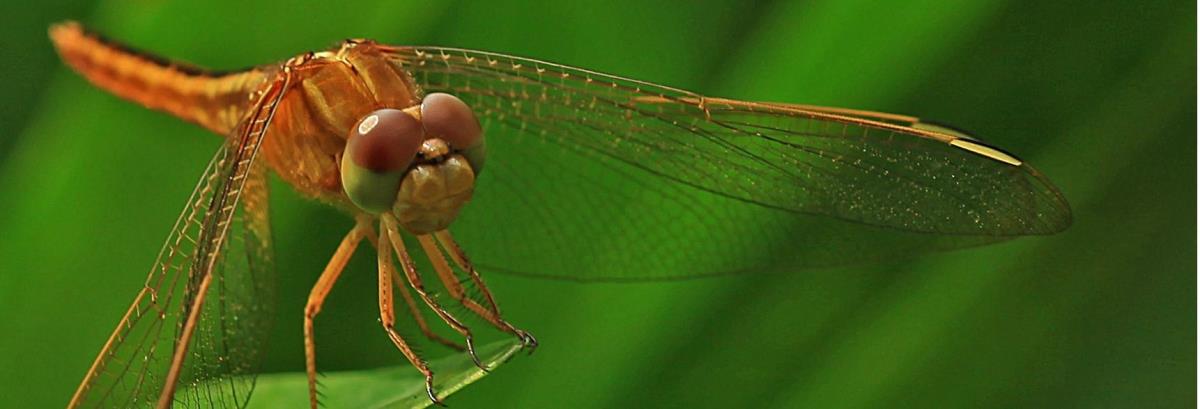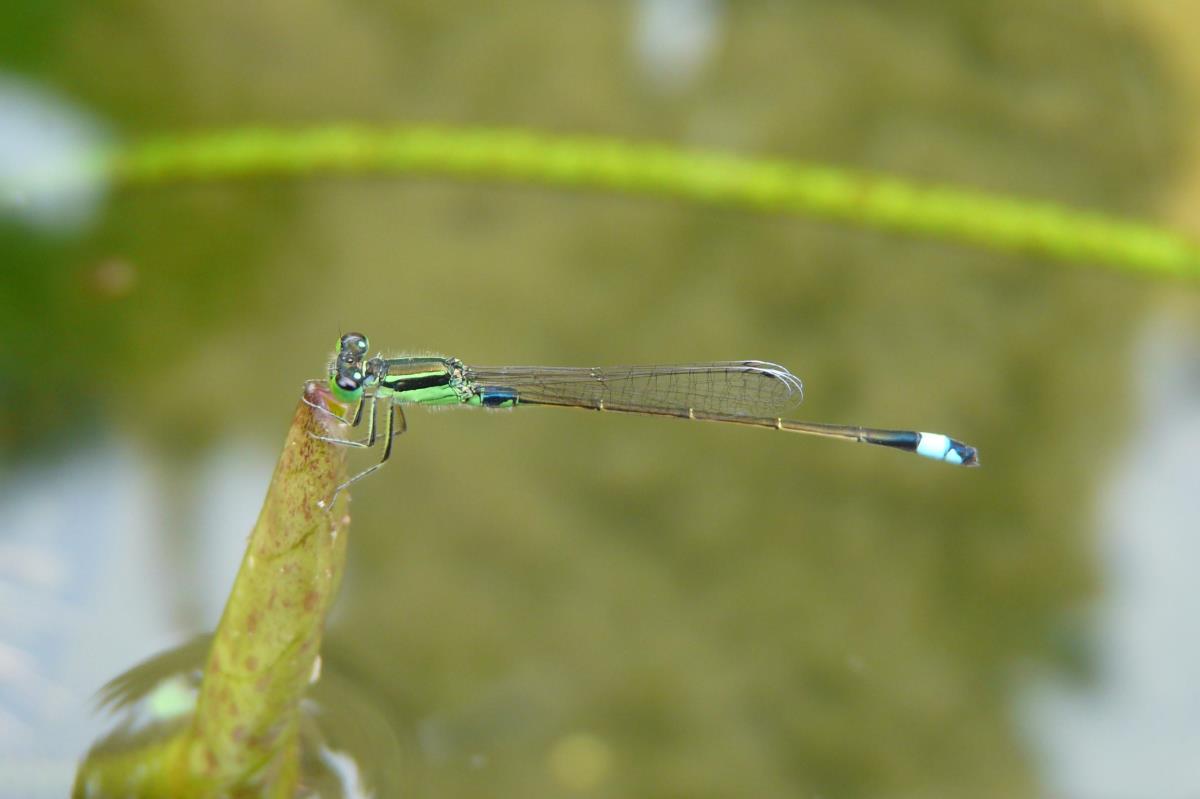Dragonflies of Jurong Lake Gardens
Dragonflies are from the suborder Anisoptera. Compared to damselflies, they are stronger fliers and have bulkier bodies. Their forewings and hindwings are shaped differently and they tend to hold their wings out horizontally at rest, like an airplane. They also have much larger compound eyes that often touch each other and take up most of their head.
Red Dragonflies (males)
Common Scarlet
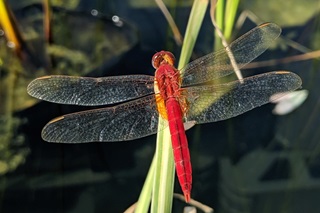 Photo credit: Tan Jing Wen Photo credit: Tan Jing Wen |
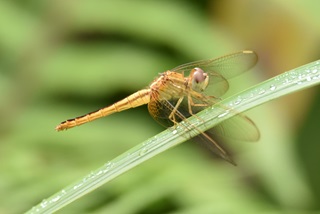 Photo credit: Nicholas Kee (NParks) Photo credit: Nicholas Kee (NParks) |
| Scientific name: | Crocothemis servilia |
| Common name: | Common Scarlet |
| Family: | Libellulidae |
 40–43 mm 40–43 mm |

This is one of the larger species of red dragonflies and is very common in Jurong Lake Gardens. The males are red from head to tail, including their eyes. They are easily confused with the Common Redbolt but can be distinguished from the latter by the distinctive dark line along the top of its abdomen. The females are light brown with the same distinctive line.

These sun-loving dragonflies can be commonly seen in our parks as well as other open habitats like freshwater marshes. They range from the Middle East throughout tropical and subtropical Asia, to New Guinea in the east.
Common Redbolt
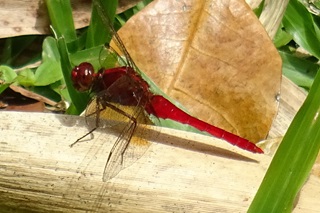 Male. Photo credit: Ruth Tan (NParks) Male. Photo credit: Ruth Tan (NParks) |
| Scientific name: | Rhodothemis rufa |
| Common name: | Common Redbolt |
| Family: | Libellulidae |
 41–44 mm 41–44 mm |

Male Common Redbolts are red throughout with a thick pale band on their thorax. Females are brown with a bright yellow band on their thorax that extends midway down the abdomen. It looks similar to the Common Scarlet but lacks the distinct dark band along the abdomen.

This sun-loving species is found in open habitats like freshwater marshes and flooded grasslands. They are widespread in tropical Asia, ranging from western India and Sri Lanka to the Solomon Islands.
Scarlet Basker
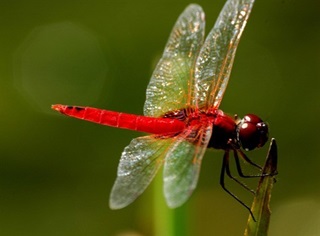 Male. Photo credit: Cai Yixiong, NParks Flora&FaunaWeb Male. Photo credit: Cai Yixiong, NParks Flora&FaunaWeb |
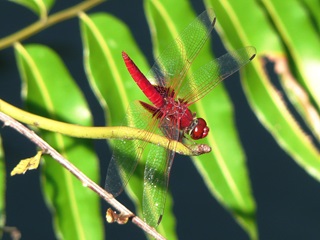 Male. Photo credit: Robin Ngiam (NParks) Male. Photo credit: Robin Ngiam (NParks) |
| Scientific name: | Urothemis signata |
| Common name: | Scarlet Basker |
| Family: | Libellulidae |
 42–45 mm 42–45 mm |

Male Scarlet Baskers have red eyes, thoraxes and abdomens with a brown patch at the base of their hindwings. Females are, in contrast, light yellowish brown with a pale amber patch at the base of their hindwings. They are identified by two diamond-shaped spots at the ends of their abdomens.

It is found in ponds in open habitats throughout Singapore. This active dragonfly is often seen fighting other odonates that intrude into their territory. It is widespread, occurring from the Indian subcontinent and Southeast Asia to eastern Australia.
Scarlet Skimmer
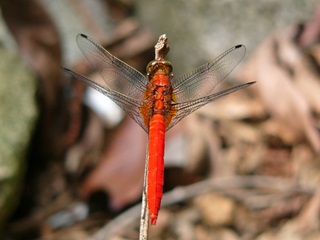 Male. Photo credit: Robin Ngiam (NParks) Male. Photo credit: Robin Ngiam (NParks) |
| Scientific name: | Orthetrum testaceum |
| Common name: | Scarlet Skimmer |
| Family: | Libellulidae |
 43–48 mm 43–48 mm |

Males have an orange brown thorax and red abdomen with light brownish grey eyes. They also have an amber patch at the base of their hindwings. Females are yellowish brown and lack the patch on their hindwings.

They inhabit open wetlands like drains, ponds and marshes.
Grenadier
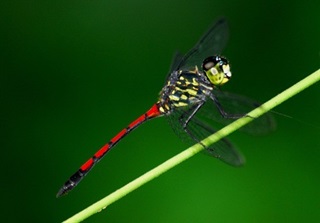 Photo credit: Cai Yixiong, NParks Flora&FaunaWeb Photo credit: Cai Yixiong, NParks Flora&FaunaWeb |
| Scientific name: | Agrionoptera insignis |
| Common name: | Grenadier |
| Family: | Libellulidae |
 37–41 mm 37–41 mm |

The Grenadier has a blotchy or mottled yellow thorax and a slender abdomen that is red except for the black tip. Males and females look similar. It can be challenging to distinguish the Grenadier from the Scarlet Grenadier, which is larger and has a different abdomen shape and thorax colouration.

This species is associated with forested habitats and generally perches in shady areas. It has been recorded in the nature reserves, various nature parks and wooded areas of Jurong Lake Gardens. It has a wide range across tropical Asia and Australasia.
Scarlet Grenadier
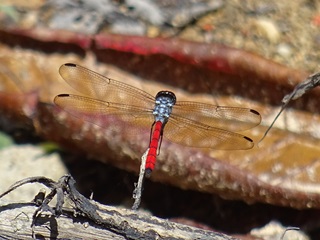 Photo credit: Ruth Tan (NParks) Photo credit: Ruth Tan (NParks) |
| Scientific name: | Lathrecista asiatica |
| Common name: | Scarlet Grenadier |
| Family: | Libellulidae |
 44–47 mm 44–47 mm |

The Scarlet Grenadier has a narrow abdomen. Males have an entirely red abdomen except for the last segment which is black. Their thorax is dark brown with yellow stripes on the sides. Females have a brownish red abdomen.

This species prefers forested areas and is usually seen perched around forest clearings surveying their surroundings for prey.
Spine-tufted Skimmer
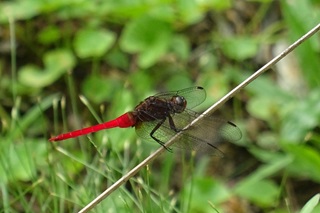 Photo credit: Ruth Tan (NParks) Photo credit: Ruth Tan (NParks) |
| Scientific name: | Orthetrum chrysis |
| Common name: | Spine-tufted Skimmer |
| Family: | Libellulidae |
 41–48 mm 41–48 mm |

Males have a dark brown thorax and red abdomen. Females are reddish brown. They are often mistaken for the Scarlet Skimmer but have a dark thorax instead of being completely red or orange brown.

They are common in our parks and widespread in tropical Asia.
Common Parasol
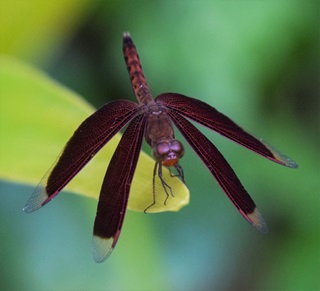 Male. Photo credit: Goh Pei Shuan (NParks) Male. Photo credit: Goh Pei Shuan (NParks) |
-crop_robin.ashx?h=240&w=320) Female. Photo credit: Robin Ngiam (NParks) Female. Photo credit: Robin Ngiam (NParks) |
| Scientific name: | Neurothemis fluctuans |
| Common name: | Common Parasol |
| Family: | Libellulidae |
 30–34 mm 30–34 mm |

Males are striking and have a reddish brown thorax and abdomen with maroon wings that have transparent tips. Females are duller in colour with clear wings. Immature males look similar to females except for their wing markings.

It is widespread across tropical Asia. It is the most common dragonfly in Singapore, even frequenting places that are far from a water source.
Crimson Dropwing
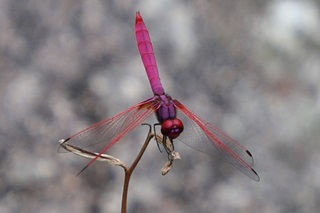 Male. Photo credit: Ruth Tan (NParks) Male. Photo credit: Ruth Tan (NParks) |
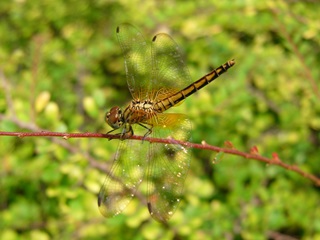 Female. Photo credit: Robin Ngiam (NParks) Female. Photo credit: Robin Ngiam (NParks) |
| Scientific name: | Trithemis aurora |
| Common name: | Crimson Dropwing |
| Family: | Libellulidae |
 32–35 mm 32–35 mm |

The eyes, thorax and abdomen of males are bright pink, while females are golden yellow with black markings on the sides of their abdomen.

This species is very common and inhabits all sorts of urban wetlands. They can often be spotted perched on shrubs, basking in the sun.
Yellow/Orange Dragonflies (males)
Common Amberwing
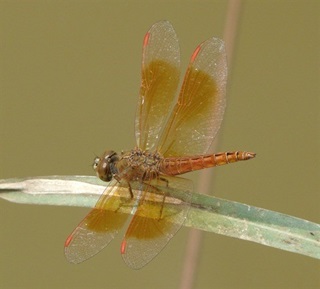 Male. Photo credit: Robin Ngiam (NParks) Male. Photo credit: Robin Ngiam (NParks) |
| Scientific name: | Brachythemis contaminata |
| Common name: | Common Amberwing |
| Family: | Libellulidae |
 29–31 mm 29–31 mm |

True to its name, male Common Amberwings have beautiful amber tints on all their wings. Females look very different with a pale yellow thorax and yellowish orange wing spots instead.

They are very common in ponds, lakes and marshes. Their scientific name contaminata refers to this species’ ability to survive even in polluted water. They can usually be found in large numbers.
Saddleback Glider
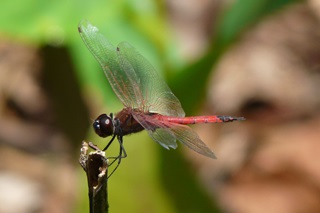 Photo credit: Robin Ngiam (NParks) Photo credit: Robin Ngiam (NParks) |
| Scientific name: | Tramea transmarina |
| Common name: | Saddlebag Glider |
| Family: | Libellulidae |
 53–54 mm 53–54 mm |

The Saddlebag Glider has a dark brown patch at the base of its hindwings near the thorax, resembling a saddlebag and thus giving it its name. Their eyes are dark brown above and greyish white below.

They are common in Singapore and occur in well-vegetated ponds and drains.
Wandering Glider
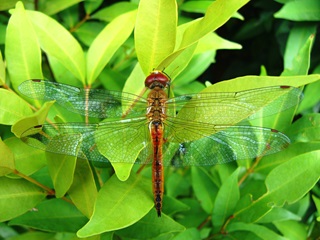 Photo credit: Robin Ngiam (NParks) Photo credit: Robin Ngiam (NParks) |
| Scientific name: | Pantala flavescens |
| Common name: | Wandering Glider |
| Family: | Libellulidae |
 45–47 mm 45–47 mm |

This dragonfly is mainly yellow in colour. It has a series of long, diamond-shaped spots along the midline of its abdomen. Their broad wings are clear except for a small but distinct dark mark at each of the tips. Males and females look similar.

The Wandering Glider occurs in open habitats in Singapore and is often present in swarms, foraging around open areas in search of prey.
They are the most widespread species of dragonfly and have a global range extending from the Americas to Asia.
White-barred Duskhawk
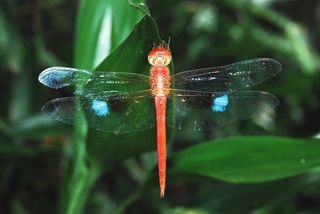 Photo credit: Robin Ngiam (NParks) Photo credit: Robin Ngiam (NParks) |
| Scientific name: | Tholymis tillarga |
| Common name: | White-barred Duskhawk |
| Family: | Libellulidae |
 44–47 mm 44–47 mm |

The males are dull orange with a light brown bar and white patches on each hindwing. Females are pale brown with clear wings that lack patches. Before maturity, males resemble females.

Mostly active in the late afternoon, they perch vertically below plants for shade during the rest of the day. They are found throughout Singapore in open habitats like ponds, lakes and slow-flowing streams. Their global distribution ranges throughout tropical and subtropical Africa, Asia, Australia and Micronesia (islands in the western Pacific Ocean).
Blue Dragonflies (males)
Common Chaser
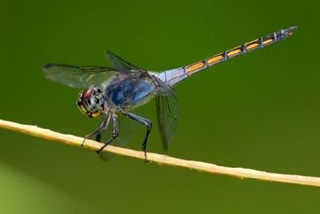 Male. Photo credit: Anthony Quek Male. Photo credit: Anthony Quek |
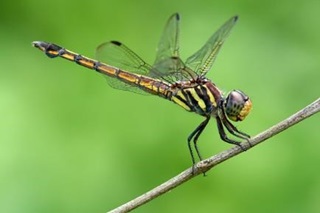 Female. Photo credit: Anthony Quek Female. Photo credit: Anthony Quek |
| Scientific name: | Potamarcha congener |
| Common name: | Common Chaser |
| Family: | Libellulidae |
 43–45 mm 43–45 mm |

The first four segments of the abdomen of the males are powdery blue while the rest of the abdomen is black with orange markings. Females have yellow and black stripes on the sides of their thorax, a black abdomen with dull orange markings and a notable flap near the tip.

They occur all over Singapore, preferring open ponds and slow-flowing waters in disturbed habitats. They are also widely distributed in areas ranging from tropical Asia to Australia.
Blue Dasher
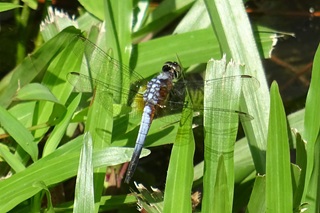 Photo credit: Ruth Tan (NParks) Photo credit: Ruth Tan (NParks) |
| Scientific name: | Brachydiplax chalybea |
| Common name: | Blue Dasher |
| Family: | Libellulidae |
 33–35 mm 33–35 mm |

This dragonfly is distinctive, with males sporting a bluish body coupled with a yellowish tint at the base of its wings. It has a broad dark tip at the end of its abdomen. Females have clear wings and a yellow abdomen with a black streak.

They are very common and found in ponds in many of our parks, particularly those that are well-vegetated.
Blue Percher
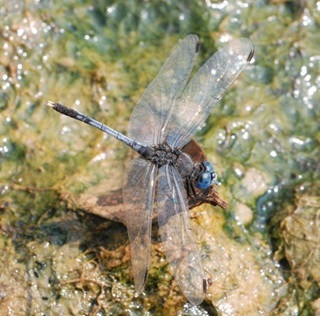 Male. Photo credit: Robin Ngiam, NParks Flora&FaunaWeb Male. Photo credit: Robin Ngiam, NParks Flora&FaunaWeb |
| Scientific name: | Diplacodes trivialis |
| Common name: | Blue Percher |
| Family: | Libellulidae |
 29–33 mm 29–33 mm |

A small dragonfly, its males are light bluish with bright blue eyes and a black abdomen tip with white anal attachments, known as appendages. Females have a pale greenish yellow marking on their black bodies with eyes that are brown above and yellow below.

It is commonly found in open marshes, drains and disturbed habitats. They are not always found near water sources, and often fly very close to the ground. It has a wide range encompassing tropical and subtropical Asia and Australasia.
Trumpet Tail
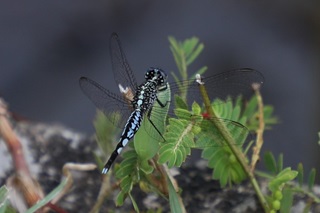 Male. Photo credit: Ruth Tan (NParks) Male. Photo credit: Ruth Tan (NParks) |
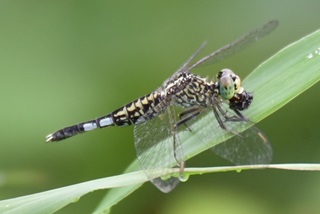 Female. Photo credit: Nicholas Kee (NParks) Female. Photo credit: Nicholas Kee (NParks) |
| Scientific name: | Acisoma panorpoides |
| Common name: | Trumpet Tail |
| Family: | Libellulidae |
 27–29 mm 27–29 mm |

A key feature of this dragonfly is its bulging abdomen that narrows towards the tip. Mature males are blue while females are light green.

It is commonly found in most of our parks and is often seen around ponds with many plants.
Black Dragonflies (males)
Common Flangetail
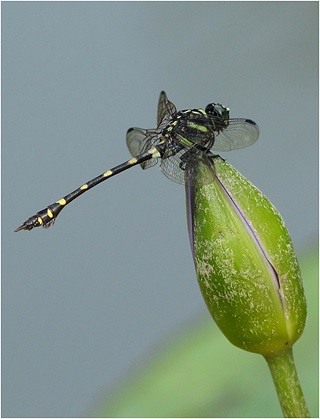 Photo credit: Ong Chwee Sia Photo credit: Ong Chwee Sia |
| Scientific name: | Ictinogomphus decoratus |
| Common name: | Common Flangetail |
| Family: | Gomphidae |
 64–68 mm 64–68 mm |

It has a heavily-built body with a distinctive yellow and black pattern and a long slender abdomen. Greenish yellow bands and spots cover its black body. Its eyes are well separated and greyish green in colour. Females and males look similar.

The Common Flangetail prefers large, open expanses of water such as Jurong Lake and other large lakes and reservoirs.
Variegated Green Skimmer
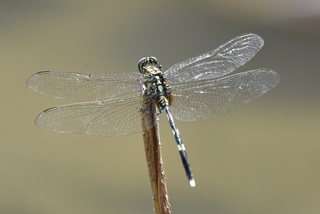 Photo credit: Nicholas Kee (NParks) Photo credit: Nicholas Kee (NParks) |
| Scientific name: | Orthetrum sabina |
| Common name: | Variegated Green Skimmer |
| Family: | Libellulidae |
 47–52 mm 47–52 mm |

They are easily recognised by their pale green colour and white markings on their abdomens. Females look similar to males.

This is a very common dragonfly that is found in a wide variety of open wetlands, including drains and flooded fields.
Yellow-barred Flutterer
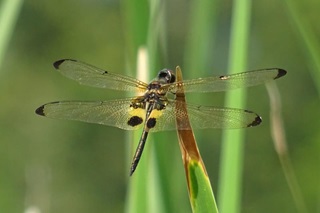 Photo credit: Ruth Tan (NParks) Photo credit: Ruth Tan (NParks) |
| Scientific name: | Rhyothemis phyllis |
| Common name: | Yellow-barred Flutterer |
| Family: | Libellulidae |
 39–41 mm 39–41 mm |

It has a dark thorax and abdomen with a metallic sheen while the base of the hindwing has unmistakable yellow and dark bars. Males and females look similar.

This species is common throughout Singapore and is often seen far from water. Swarms of this species can sometimes be seen fluttering over grassy fields together with Wandering Gliders in search of aerial prey.
Banner: Common Scarlet (female). Photo credit: Ong Chwee Sia


